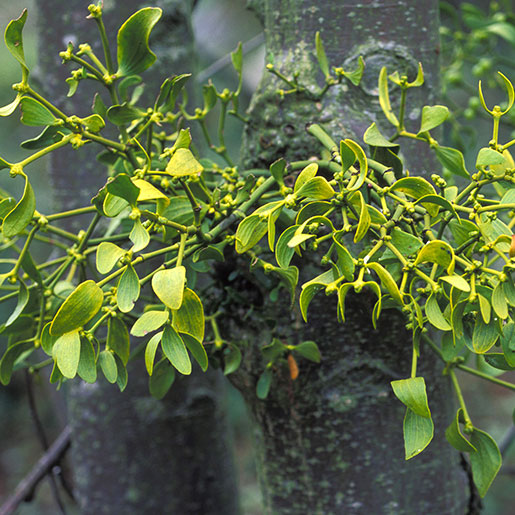European Mistletoe

Common Names: European mistletoe
Latin Names: Viscum album
Background
- European mistletoe is a semiparasitic plant that grows on several types of common trees such as apple, oak, pine, and elm. European mistletoe is different from American mistletoe, which is a type of mistletoe that grows in the United States and is used as a holiday decoration.
- European mistletoe has been used for centuries in traditional medicine for a variety of conditions, including seizures, headaches, and menopause symptoms. Today, European mistletoe is promoted as a treatment for cancer.
- In Europe, European mistletoe extracts that are given by injection are sold as prescription drugs. European mistletoe may also be taken orally (by mouth) as a dietary supplement. The U.S. Food and Drug Administration (FDA) has not approved the use of European mistletoe as a treatment for cancer or any other medical condition.
How Much Do We Know?
- Although European mistletoe has been studied as a treatment for cancer, its effects are not well understood because much of the research has been of poor quality. Most studies have evaluated European mistletoe administered through injection by a health care provider. Very little research has looked at European mistletoe taken orally.
What Have We Learned?
- European mistletoe is not a proven cancer treatment. It should not be used as a treatment for cancer outside of clinical trials (studies in people).
- There have been clinical trials of European mistletoe for cancer treatment, mostly in Europe. Although some trials indicated that European mistletoe improved survival or quality of life, many of the trials had major weaknesses that raise doubts about their findings. These weaknesses have included small numbers of patients, lack of information about the patients, lack of information about the dose of European mistletoe, and problems with the design of the studies.
- The National Center for Complementary and Integrative Health and the National Cancer Institute performed a preliminary trial to evaluate the safety of injected European mistletoe extract in combination with a cancer drug in patients with advanced cancer. It showed that patients could tolerate the herb/drug combination.
What Do We Know About Safety?
- European mistletoe berries and leaves can cause serious harmful effects when taken orally.
- Injected European mistletoe extract may cause soreness and inflammation at the injection site, headache, fever, and chills. A few severe allergic reactions have been reported.
- If you take any type of medicine, talk with your health care provider before using European mistletoe or other herbal products; some herbs and medicines interact in harmful ways.
- European mistletoe is probably unsafe for use during pregnancy. Little is known about whether it’s safe for use while breastfeeding.
Keep in Mind
- Take charge of your health—talk with your health care providers about any complementary health approaches you use. Together, you can make shared, well-informed decisions.
- Federal Regulation of Herbal Products
- Depending on what’s in them, how they’re intended to be used, and how they’re administered (orally or topically), herbal products are regulated in a variety of ways. Many herbal products intended for oral use are marketed as dietary supplements. The rules for making and distributing dietary supplements are less strict than those for drugs.
- Unlike drugs, dietary supplements are not approved by the FDA before they are sold to the public. When public health concerns arise about the safety of a dietary supplement or an ingredient including an herb, the FDA can take action to protect the public. Manufacturers and distributors of supplements are responsible for evaluating the safety and labeling of their products before marketing to ensure that they meet all regulatory requirements.
NCCIH Clearinghouse
The NCCIH Clearinghouse provides information on NCCIH and complementary and integrative health approaches, including publications and searches of Federal databases of scientific and medical literature. The Clearinghouse does not provide medical advice, treatment recommendations, or referrals to practitioners.
Toll-free in the U.S.: 1-888-644-6226
Telecommunications relay service (TRS): 7-1-1
Website: https://www.nccih.nih.gov
Email: info@nccih.nih.gov (link sends email)
PubMed®
A service of the National Library of Medicine, PubMed® contains publication information and (in most cases) brief summaries of articles from scientific and medical journals. For guidance from NCCIH on using PubMed, see How To Find Information About Complementary Health Practices on PubMed.
Website: https://pubmed.ncbi.nlm.nih.gov/
Office of Dietary Supplements (ODS), National Institutes of Health (NIH)
ODS seeks to strengthen knowledge and understanding of dietary supplements by evaluating scientific information, supporting research, sharing research results, and educating the public. Its resources include publications (such as Dietary Supplements: What You Need To Know) and fact sheets on a variety of specific supplement ingredients and products (such as vitamin D and multivitamin/mineral supplements).
Website: https://ods.od.nih.gov
Email: ods@nih.gov (link sends email)
Key References
- European mistletoe. NatMed Pro website. Accessed at naturalmedicines.therapeuticresearch.com on October 13, 2023. [Database subscription].
- Mansky PJ, Wallerstedt DB, Sannes TS, et al. NCCAM/NCI Phase I study of mistletoe extract and gemcitabine in patients with advanced solid tumors. Evidence-Based Complementary and Alternative Medicine. 2013;2013:964592.
- National Cancer Institute. Mistletoe extracts (PDQ®)–patient version. Accessed at cancer.gov/about-cancer/treatment/cam/patient/mistletoe-pdq on October 1, 2023.
This publication is not copyrighted and is in the public domain. Duplication is encouraged.
NCCIH has provided this material for your information. It is not intended to substitute for the medical expertise and advice of your health care provider(s). We encourage you to discuss any decisions about treatment or care with your health care provider. The mention of any product, service, or therapy is not an endorsement by NCCIH.